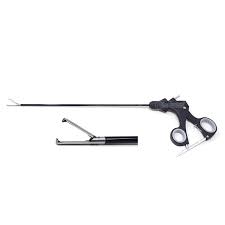Introduction
Laparoscopic clip applicators are vital surgical instruments used in minimally invasive procedures to apply hemostatic clips on blood vessels, ducts, or tissues. These clips help occlude or seal structures, commonly during procedures like laparoscopic cholecystectomy or appendectomy. The applicators are designed to work through small trocar ports, allowing surgeons to securely place clips without the need for large incisions.
Design and Structure
A typical laparoscopic clip applicator comprises three main components: the handle, shaft, and jaws. The handle is ergonomically shaped for easy control and may include a locking mechanism or trigger-style grip for precise clip deployment. The shaft is long and slender, generally ranging from 5mm to 10mm in diameter, allowing access to deep internal sites via laparoscopic ports.
At the distal end, the jaws are engineered to hold and apply the clip to the targeted structure. The jaws are spring-loaded and calibrated to ensure that each clip is applied with uniform pressure. Most clip applicators are compatible with preloaded cartridges containing titanium or polymer clips, available in different sizes (small, medium, large) depending on surgical requirements.
Types of Laparoscopic Clip Applicators
There are several types of laparoscopic clip applicators, designed to meet various surgical needs:
-
Reusable Clip Applicators: Made of stainless steel, these are durable and autoclavable. They are used with reloadable clip cartridges.
-
Disposable Clip Applicators: Preloaded with clips, these are used once to ensure sterility and avoid cross-contamination.
-
Rotating Clip Applicators: Feature a rotatable shaft, providing better maneuverability and access in tight surgical fields.
-
Single and Multi-Clip Applicators: Single-clip applicators apply one clip at a time, while multi-clip versions allow rapid, consecutive application.
Surgical Applications
Laparoscopic clip applicators are used across various surgical specialties, including:
-
General Surgery: To occlude the cystic duct and artery during gallbladder removal.
-
Gynecologic Surgery: For tubal ligation or managing bleeding vessels.
-
Urological Surgery: For vessel control during nephrectomy or prostatectomy.
-
Colorectal Surgery: To secure mesenteric vessels and tissue before transection.
These instruments offer a reliable alternative to suturing or energy-based sealing, reducing operative time and improving safety.
Sterilization and Maintenance
Reusable applicators require thorough cleaning, disinfection, and sterilization between procedures. Regular inspection is essential to ensure proper clip loading and deployment. Disposable versions eliminate the need for reprocessing and are ideal for high-volume or emergency settings.
Conclusion
Laparoscopic clip applicators are indispensable in modern minimally invasive surgery, offering efficient, reliable vessel and duct ligation. Their precise design, variety of types, and compatibility with different clip sizes make them a critical tool for safe and effective surgical outcomes. Whether reusable or disposable, these applicators help enhance surgical efficiency while minimizing patient risk.







Reviews
There are no reviews yet.